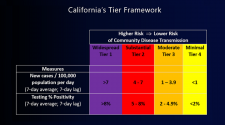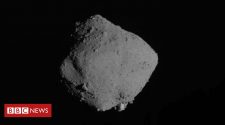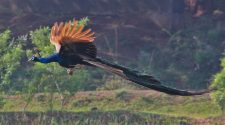Last week, ladybugs briefly took over the news cycle.
Meteorologists at the National Weather Service were looking over radar images in California on the night of June 4 when they spotted what looked like a wide swath of rain. But there were no clouds.
The meteorologists contacted an amateur weather-spotter directly under the mysterious disturbance. He wasn’t getting soaked by rain. Instead, he saw ladybugs. Everywhere.
Radar apparently had picked up a cloud of migrating ladybugs spread across 80 miles, with a dense core ten miles wide floating 5,000 feet to 9,000 feet in the air. As giant as the swarm was, the meteorologists lost track of it. The ladybugs disappeared into the night.
Compared to other animal migrations, the migrations of insects are a scientific mystery. It’s easy to spot a herd of wildebeest making its way across the savanna. Insects, even in huge numbers, move from place to place without much notice. One day you look around, and ladybugs are everywhere.
“The migrations themselves are totally invisible,” said Jason Chapman, an ecologist at the University of Exeter in Britain.
Dr. Chapman and his colleagues are using radar to bring insect migrations to light. The scientists help run a unique network of small radar stations in southern England designed to scan the sky 24 hours a day, spotting insects flying overhead.
“These radars are fantastic,” said Dr. Chapman. “We have a lot of information about every individual insect that flies over overhead, including a measure of the shape and a measure of their size.”
Recently, Dr. Chapman and his colleagues decided to scan their images for one kind of insect in particular, known as hoverflies.
You’ve probably seen a hoverfly, but you may have thought you were looking at a wasp or a bee. Hoverflies are harmless, but they have evolved to mimic stinging insects as a way to scare away predators.
Hoverflies provide two big ecological benefits. As larvae, they defend gardens and farms by eating aphids. As adults, they pollinate flowers as they eat nectar and pollen.
“I don’t think you could create a more useful insect,” said Dr. Chapman.
Scientists had clues that some species of hoverflies migrate, but they knew little about the timing or the scale of their movements.
To tally the hoverflies migrating through southern England, Dr. Chapman and his colleagues brought one species, the marmalade hoverfly, into the lab and bounced radar off it. They determined the distinctive radar signature of the insect, and then searched for it in scans made by their network of instruments.
The results, published on Thursday in the journal Current Biology, revealed hordes of the insects zipping overhead. The scientists estimate that up to 4 billion hoverflies migrate in and out of southern England each year.
But the true number is probably higher, because the radar system can only spot insects flying above 450 feet. (By comparison, there are an estimated 5 billion honeybees in managed hives in all of Britain.)
[Like the Science Times page on Facebook. | Sign up for the Science Times newsletter.]
Each fly may travel 50 or 100 miles a day, and over the course of a year’s migrations, hoverflies may go through several generations. This mass migration has a huge influence on the environment. Dr. Chapman and his colleagues estimate that the larvae produced by migrating hoverflies each year in southern England devour an average of 6 trillion aphids — which together weigh about 7,000 tons.
The flies visit billions of flowers every year. And as the insects travel along their migration route, they carry pollen over long distances. The researchers estimate that hoverflies import 3 billion to 8 billion pollen grains into southern England in the spring, and then take 3 billion to 19 billion pollen grains with them as they fly south in the fall.
The insects are important not just for the prey they eat and the pollen they carry. They themselves are tiny packages of nutrients. Many are eaten by predators; the others fertilize the soil after they die. They comprise about 80 tons of biomass, packed with 35 million calories, the researchers estimate.
“I think that people will be amazed by the scale of the migrations and the significance of the ecosystem services,” said Dr. Chapman.
Other insect species, such as ladybugs, may be making similarly mammoth migrations in other parts of the world. But there are very few researchers using radar to track them. In Australia, scientists are scanning for locusts, and Dr. Chapman is currently in China helping researchers set up a new insect-tracking network.
Understanding these migrations is all the more important, Dr. Chapman said, because many non-migrating insect populations are on the decline. By contrast, hoverfly migrations have stayed stable for the past decade.
It’s possible that they’re less vulnerable because they aren’t stuck in one place, vulnerable to pollution or climate change.
“These migratory hoverflies, in our part of the world at least, are doing rather well,” he said. “And so they may be playing an increasingly important role as we go into the future.”
















